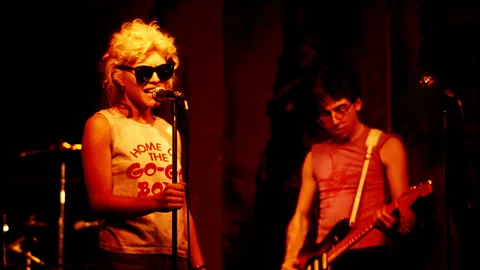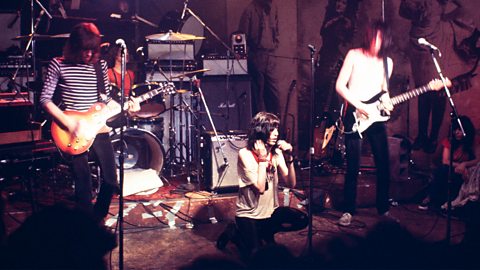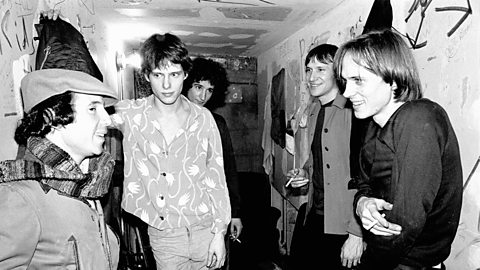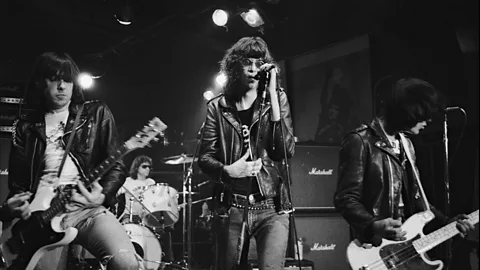By Daniel Dylan WrayFeatures correspondent

 Getty Images
Getty Images
Fifty years ago, a Manhattan dive bar on a dilapidated street began to become the home of a new musical scene – making the careers of Patti Smith, Blondie, the Ramones and many more.
Now renowned as one of the most vibrant cultural epicentres on the planet, in the early 1970s New York was a very different city. Gig venues for alternative music were sparse rather than plentiful. While Max’s Kansas City was a go-to hangout spot for the bourgeoning glam rock scene – with the likes of David Bowie, Marc Bolan, Andy Warhol and Lou Reed all frequent attendees – they booked established acts with record deals, leaving aspiring young musicians with restricted avenues.
More like this:
The Mercer Arts Center was a vital breeding ground for bands such as the New York Dolls to flourish but in 1973 it collapsed, leaving even fewer options for a new generation of bands. “There were no rock venues at the time,” Lenny Kaye, the long-time guitarist for Patti Smith tells BBC Culture. “With Patti we were mostly playing folk clubs or strange venues, like in a restaurant. There were no places for a band to go and make a stand.” But a new one was about to provide them with just that: CBGB.

 Getty Images
Getty Images
Located in the Bowery neighbourhood in Lower Manhattan, New York, the area was more synonymous with the homeless community and crime than it was a thriving mecca for groundbreaking music and a burgeoning counterculture movement. “Even though CBGB was in the heartland of Manhattan, it seemed like another universe,” says Kaye. “It was essentially a skid row. There was nobody on the street except for the dispossessed, so it seemed like a perfect place for something to happen. And it did.”
Soon after it opened, in December 1973, members of the proto-punk art-rock outfit Television came across the venue and made enquiries about playing there. The owner, Hilly Kristal, a burly bearded man who had been promoting music since the 1960s, had only one stipulation for any bands that wanted to play his new venue: original music only – no covers. And so 50 years ago, in the spring of 1974, Television began playing there regularly. Others soon followed, quickly cementing its reputation as the home of a new rock scene – one that, unbeknown to the small circle of friends frequenting the place, would soon change the future of alternative music.
What the venue was like
Inside it was more grubby dive bar than glitzy music venue. There was a small stage – a bigger one was later built where the pool table was – and dog faeces could often be found on the floor from Kristal’s dog Jonathon who was known to roam free around the club. “It was very scuzzy, but it made sense right off the bat,” says filmmaker Amos Poe, who had begun shooting all the bands playing there and would release a film featuring them, Blank Generation, in 1976. “It wasn’t like a venue that you had seen before.”
The Ramones would play a 20-minute set, five minutes of which would be them arguing, storming off, coming back, and starting again – Lenny Kaye
The club was located below a cheap single-room occupancy hostel favoured by the homeless, and it wasn’t uncommon to have to dodge bottles dropping from the windows above when people would loiter outside to chat in between bands and get some air. It was far from a hip destination to begin with. “It was mostly filled with what I call professional drinkers,” the photographer Roberta Bayley, who worked the door at the club and photographed the bands who played there in the early years, tells BBC Culture. “I went to see the first Television show, and it was very sparsely attended. It was mostly friends and other aspiring band members.”
Although word about the new venue quickly spread around a small number of bands who were looking for somewhere to play, it remained a self-contained world for a period. “CBGB was a secret for about two years,” Blondie drummer Clem Burke tells BBC Culture. “Initially, it was more like a sit-down cabaret atmosphere – it was very bohemian. There were no [logo] t-shirts, no punks, no pogoing. That all came much later. It was just people sitting at tables with candles lit nodding their heads to Television.”

 Getty Images
Getty Images
While the club would later become synonymous with punk, its musical roots were much broader. The venue had originally set out to play country, blues and bluegrass (hence the name CBGB) but by welcoming a ragtag bunch of experimental kids who promised to bring buddies who would spend money at the bar, it soon became something else. “All the bands were different from each other,” says Kaye. “Television’s Tom Verlaine once said that each band was like an individual idea. It would be later lumped under punk but it was more of a sensibility, it wasn’t a musical style. It became a remarkable incubator for a lot of creative ideas, and I think one of the main reasons why that happened was that it was left alone for a long time to find itself.”
Its musical range
What grew was a scene around a number of bands who were connected by proxy, via sensibility and camaraderie more than genre. Blondie became the house pop band, Television began to hone an immaculate and inimitable style of guitar music, The Patti Smith Group merged poetry with flavours of 1960s garage rock, and Talking Heads made strange, angular, art-rock. Meanwhile Mink Deville claimed to be a rhythm and blues band at heart, Johnny Thunders and the Heartbreakers picked up where the New York Dolls left off, and the Ramones became the blueprint for modern punk music that went on to define the club.
It became a place for unsigned bands to find their own groove, whereas more traditional venues would already expect bands to have achieved a level of success to play there. “CBs was the first place to be available for people really low on the list,” says Bayley. “Not only did they not have record contracts but they had no following and, in a lot of cases, had no great musical ability. It was like getting a rehearsal hall where you could rehearse in front of people and develop as a band.”
Kaye also flags the venue’s hugely important function as a place for some of what turned out to be the most pioneering bands of the era to experiment. “All of [them] came there figuring themselves out,” he says. “The Ramones would play a 20-minute set, five minutes of which would be them arguing, storming off, coming back, and starting again. Everybody was trying to understand who they could be.”
There were just so many great artists proliferating in one place that it couldn’t help but explode into something huge – Amos Poe
The opportunity to perform week after week, sometimes night after night, resulted in some of the most classic and era-defining alternative rock records of the decade being shaped and sculpted on that stage. “We played for six straight weeks with Television, Thursday through Sunday,” remembers Kaye. “Before that we were playing once a month, opening for a folk act somewhere in Greenwich Village, but having six weeks to play two sets a night with one of our sibling bands really helped us figure out where our improvisations were going. It was the kind of environment where you could flight test what you were about and take chances and see how it evolved. By the time we finished, we had figured out how we would make our debut album Horses.”

 Getty Images
Getty Images
The social side of the club was also significant: it became a meeting ground for numerous likeminded people to exchange ideas, hatch plans and begin creative endeavours. “Suddenly you’re part of a crowd,” remembers Poe. “You’re an alien up until that moment, and suddenly you’re in something, and I think that was part of it as well. Like, ‘oh, okay, I’m accepted here. I’m not some strange weird guy because there were writers, photographers, filmmakers, musicians, painters, sculptors, playwrights and poets there too. There were just so many great artists proliferating in one place that it couldn’t help but explode into something huge.”
Life after its golden era
By the end of the decade a healthy number of those key early bands were playing huge theatres and well on their way to an enduring career. By which point the club had changed as it entered an era more defined by hardcore punk. “When the word punk moved from a small p to a capital P, the vibe changed,” recalls Kaye.
Hardcore punk was harder, faster, more aggressive and arguably much more macho than the style of music that had preceded it, and so that brought with it an energy shift. “Then punk became a certain definition of what a band needed to be on that stage,” says Kaye. “I like it when the genres and the borders blur. When nobody really knows what is happening and so they don’t fit. And when you don’t fit, that’s when you come up with something unique. The CBGB golden era was about that.”
After its hardcore punk spell, the club fell back into a more genre-fluid policy, welcoming a variety of up-and-coming new bands, although never managing to repeat its mid-1970s peak before it closed in 2006 for good. Kaye performed one last final concert there with Patti Smith in October of that year. “It was a very emotional experience to look out at the audience and see so many ghosts from a stage that I’d spent many a time on,” he recalls. “I felt very moved.”

 Getty Images
Getty Images
Many people connected to CBGB have died over the years, including Kristal and several band members, but for those still with us who spent time in its grimy, dimly lit, graffiti-strewn presence, the potency of the memories have not faded even half a century on. “It was like a rock’n’roll high school,” says Burke. “When you see people from back in the day, there’s a shared history right away, there’s a connection that endures. If we were not at CBGB, Blondie would not have had the success that we had – that was the stepping stone. That whole nucleus of the first wave of bands created an energy that propelled us into international awareness. Without that whole contingent of bands, you wouldn’t have had the success of the few. All the bands propped one another up.”
Kaye hopes that its spirit is one that lives on. “I’m sure somewhere there is a CBGB of the 21st Century taking root,” he says. “With a whole new generation of musicians, artists and writers. I really believe that the club helped move our culture forward, and that’s really all one can ask of any performance venue.”
If you liked this story, sign up for The Essential List newsletter – a handpicked selection of features, videos and can’t-miss news delivered to your inbox every Friday.
If you would like to comment on this story or anything else you have seen on BBC Culture, head over to our Facebook page or message us on Twitter.





